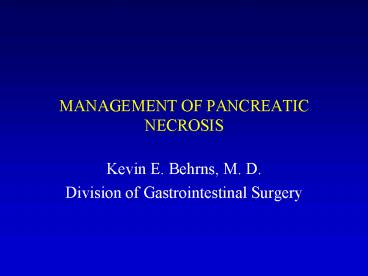MANAGEMENT OF PANCREATIC NECROSIS - PowerPoint PPT Presentation
1 / 22
Title:
MANAGEMENT OF PANCREATIC NECROSIS
Description:
Pancreatic necrosis- diffuse or focal areas of non-viable pancreatic ... INDICATIONS FOR DEBRIDEMENT OR NECROSECTOMY? Absolute indications. Relative indications ... – PowerPoint PPT presentation
Number of Views:641
Avg rating:3.0/5.0
Title: MANAGEMENT OF PANCREATIC NECROSIS
1
MANAGEMENT OF PANCREATIC NECROSIS
- Kevin E. Behrns, M. D.
- Division of Gastrointestinal Surgery
2
PANCREATIC NECROSISDefinition
- Pancreatic necrosis- diffuse or focal areas of
non-viable pancreatic parenchyma, which is
typically associated with peripancreatic fat
necrosis. - Atlanta International Symposium
- Arch Surgery 1993128586
3
PANCREATIC NECROSISSurgical Indications
- WHAT ARE THE SURGICAL
- INDICATIONS FOR DEBRIDEMENT OR NECROSECTOMY?
- Absolute indications
- Relative indications
4
PANCREATIC NECROSISSurgical Decision-Making
PANCREATIC NECROSIS
INFECTED NECROSIS
STERILE NECROSIS
NON-OPERATIVE MANGEMENT VS. NECROSECTOMY
NECROSECTOMY
5
PANCREATIC NECROSISInfected Necrosis
- Mandates a semi-urgent operation
- Removal of all necrotic pancreas and
peripancreatic tissues - May require 1-3 operations
- Preferred method is to delay initial operation
until necrosis demarcated
6
PANCREATIC NECROSISInfected Necrosis
- Outcomes
- Mortality 6-24
- Morbidity 34-50
- Bacteria
- Staph
- E. coli
- Klebsiella
- Ann Surg 1998228676
- 2000234619
- 2001234572
7
PANCREATIC NECROSISInfected Necrosis
Ann Surg 2000232619
8
PANCREATIC NECROSISSterile Necrosis
- WHAT DISTINGUISHES STERILE NECROSIS FROM INFECTED
NECROSIS? - Retroperitoneal air within necroma on CT
indicates gas-producing organism and infected
necrosis. - Role of FNA of necrotic pancreatic and
peripancreatic tissue.
9
PANCREATIC NECROSISSterile Necrosis
- Utility of FNA
- Good sensitivity and specificity
- Highly dependent on accurate needle placement in
necrotic tissue (not nearby fluid collection) - Surgeons Perspective- not that useful
- Timing is everything in pancreatic necrosectomy
- Early positive FNA forces surgeons hand when
pancreatic necrosis not demarcated - May result in multiple operations and increased
risk of morbidity and mortality - CONSULT SURGEON PRIOR TO FNA
10
PANCREATIC NECROSISSterile Necrosis
- Controversial management
- Non-operative management
- Most of the world
- Operation for all patients with pancreatic
necrosis - MGH
11
PANCREATIC NECROSISSterile Necrosis-
Non-Operative Management
Ann Surg 2000232619
12
PANCREATIC NECROSISSterile Necrosis
- Which patients are
- likely to get
- infected necrosis?
13
PANCREATIC NECROSISSterile Necrosis
- What are the outcomes with planned operative
management of sterile necrosis? - Mortality 6.2
- Ann Surg 1998228676
14
PANCREATIC NECROSISSterile Necrosis
- DO ALL PATIENTS WITH NON-OPERATIVE TREATMENT OF
STERILE NECROSIS GET WELL? - NO!
- Subgroup of patients that never develop infection
but have persistent nausea, vomiting, abdominal
pain. Fail to thrive
15
PANCREATIC NECROSISSterile Necrosis
- When should patients with sterile necrosis that
induces persistent symptoms undergo operation? - About one month after diagnosis if no
improvement - Ann Surg 1998228676
16
PANCREATIC NECROSISSterile Necrosis
- What are the outcomes of patients that have
delayed operation for sterile pancreatic
necrosis? - Ann Surg 2001 234572
17
PANCREATIC NECROSISSterile Necrosis
- What factors predict survival from pancreatic
necrosectomy? - Age
- APACHE II score
- Time to surgery
- Survivors- 39 days
- Non-survivors- 23 days
- Brit J Surg 2003901542
18
PANCREATIC NECROSISQuality of care
- HOW CAN WE PROVIDE HIGHESTQUALITY OF CARE FOR
PATIENTS WITH PANCREATITIS?
19
PANCREATIC NECROSISSurgical Treatment Guidelines
- International Association of Pancreatology (IAP)
evidence-based guidelines for surgical management
of acute pancreatitis - Mild acute pancreatitis does not require surgery
- Antibiotics decrease infection rates but not
mortality in CT-proven necrotizing pancreatitis - Patients with sterile necrosis should undergo
operation only in selected cases - Pancreatology 20022565
20
PANCREATIC NECROSISSurgical Treatment Guidelines
- IAP recommendations (continued)
- Patients with infected necrosis and clinical
presentation of sepsis should have surgery or
radiological drainage - Early surgery (lt14 days) not recommended unless
special circumstances - Surgical operations should favor organ-preserving
approach - Cholecystectomy should be performed at operation
- Pancreatology 20022565
21
PANCREATIC NECROSISSurgical Treatment Guidelines
- IAP recommendations (continued)
- In gallstone-induced edematous pancreatitis,
cholecystectomy should be performed during
initial hospitalization - In gallstone-induced necrotizing pancreatitis,
cholecystectomy should delayed until inflammatory
response subsides - Endoscopic sphincterotomy is alternative to
cholecystectomy in high-risk patients - Pancreatology 20022565
22
PANCREATIC NECROSISConclusion
- Necrotizing pancreatitis accounts for 10 of all
pancreatitis but is lethal disease - Surgical consult should be obtained in the ER
- Many, if not all, patients should be admitted to
surgical service - Management relies on team effort of surgeons,
endoscopist, intensivist, radiologist,
interventional radiologist, primary care
physician, etc. - Gallstone-induced edematous pancreatitis should
have surgical consult prior to discharge

